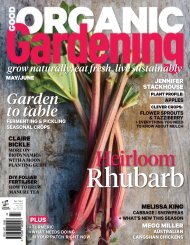1. Good Organic Gardening - January-February 2016
1. Good Organic Gardening - January-February 2016
1. Good Organic Gardening - January-February 2016
You also want an ePaper? Increase the reach of your titles
YUMPU automatically turns print PDFs into web optimized ePapers that Google loves.
Disease distress | PLANT HEALTH<br />
Grow plants in the right season.<br />
Keep plants well watered and fed —<br />
stress on the plants invites trouble.<br />
*** Watch for the yellow-and-black<br />
fungus-eating lady beetles, Psyllobora<br />
vigintimaculata. Believe it or not, they actually<br />
eat the mildew but, even though<br />
they do a good job, these little guys are<br />
never quite enough to get on top of a<br />
full-blown outbreak.<br />
Rust<br />
Once again, rust is a broad term used for a<br />
group of fungal species that attack a large<br />
variety of plants.<br />
The common symptoms of rust are the<br />
circular fruiting bodies or spores, which will<br />
generally appear on the undersides of the<br />
leaves and can be yellow to orange to brown<br />
in colour. The tops of the leaves will often<br />
have a yellow mottled appearance and in a<br />
severe enough case of rust the foliage may<br />
even drop off.<br />
Beans, geraniums, snapdragons, orchids ...<br />
there’s a long list of plants that rust can affect.<br />
Control<br />
<strong>Organic</strong> registered fungicides are worth a<br />
go. Remember to spray the undersides of<br />
the leaves.<br />
Watering early in the morning rather than<br />
late in the evening gives plants time to<br />
dry out before nightfall. This can help<br />
reduce the incidence of fungal problems.<br />
Make sure any susceptible plants have<br />
good airflow.<br />
Give regular feeding and applications of<br />
seaweed to strengthen cell walls of plants.<br />
Sooty mould<br />
This disease appears on plants as a black<br />
soot-like mould covering all parts of the plant,<br />
from leaves to fruit and stems. A multitude of<br />
plants are susceptible to sooty mould issues,<br />
from citrus to gardenias.<br />
The reason you have black sooty mould<br />
on your plants is a little tricky because the<br />
mould doesn’t just show up on its own;<br />
there’s also a secondary infection from the<br />
presence of a sap-sucking insect. The insect<br />
attacking your plant is literally sucking the<br />
goodness out of it, then excreting a sticky<br />
honeydew substance all over the plant. It’s on<br />
the excretion that the sooty mould grows.<br />
And as long as the particular sap sucker<br />
is in place, the sooty mould will keep being<br />
a problem. Indentify the sap-sucking insect<br />
and remove it to break the cycle and rid your<br />
plants of sooty mould.<br />
Control<br />
Here, the insect needs to be identified and<br />
then the appropriate organic control used or<br />
preventive measure put in place.<br />
A lot of sap-sucking insects such as<br />
scale, aphids, thrips and mealybugs can<br />
be controlled with Eco-oil or other oilbased<br />
plant sprays.<br />
Eco-neem is registered to control a variety<br />
of sucking insects on ornamental plants.<br />
Keep your plants healthy with adequate<br />
feeding and water to make them less<br />
prone to insect attack in the first place.<br />
Remove the sooty mould once the<br />
insect infestation has been dealt<br />
with. This is relatively easy as a lot<br />
of the sooty mould will flake off. Any<br />
residual mould can be hosed off. A bit<br />
of warm soapy water before hosing<br />
will help.<br />
It hardly needs reiterating that prevention is<br />
always better than cure. The best prevention<br />
includes seasonal growing, good soil<br />
preparation, regular watering and mulching,<br />
fertilising for optimal growth and applications<br />
of helpful substances like seaweed and<br />
gypsum for strengthening cell walls and<br />
general good health.<br />
Did you know?<br />
The Environmental Toothbrush<br />
TM is a simple solution<br />
to help save our planet.<br />
In Australia we put over 30 Million<br />
Plastic toothbrushes (1000 tonnes)<br />
into landfill each year. The plastic<br />
they are made from will not break<br />
down in your lifetime nor in the<br />
lifetime of your children.<br />
Made from bamboo, they are biodegradable and environmentally<br />
sustainable.<br />
Available in Adult Soft, Adult Medium and Child Soft<br />
A better way to do the washing!<br />
We all know that laundry detergents are<br />
toxic, for us and for the environment. But,<br />
did you know that Soap Nuts will do an<br />
outstanding job cleaning your washing<br />
with no need for fabric softeners or other<br />
additives? Or use them as soap for<br />
personal use, or an outstanding general<br />
cleanser. Say goodbye to those skin<br />
allergies caused by your detergents!<br />
From 100g to 1kg<br />
<strong>Good</strong> <strong>Organic</strong> <strong>Gardening</strong> | 57
















